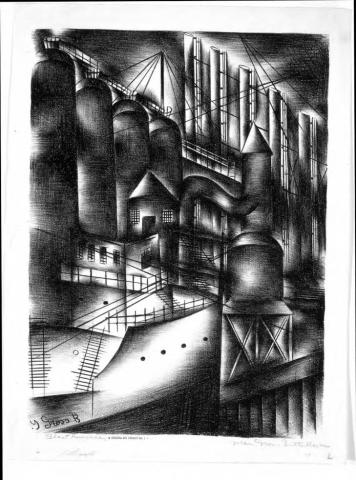GROSS-BETTELHEIM, JOLAN (1900 - 1972), was a Hungarian artist and activist who attended the CLEVELAND INSTITUTE OF ART. Remembered for her stunning lithographs, Gross-Bettelheim’s art was deeply influenced by the politics and culture of WWII and the Cold War era.
Gross-Bettelheim was born in Hungary in 1900, and enrolled at the Kunstgewerbeschule, vocational arts school, at age 19. Between 1919 and 1925, Gross-Bettelheim pursued her studies and training across Europe, working at the Berlin Academy of Fine Arts and later moving to Paris where she dabbled in the capital’s popular modernist movements. In 1925, the young artist married the Hungarian-American psychiatrist Frigyes Bettelheim. The couple moved to Cleveland, Ohio, that same year, drawn to the city by the large HUNGARIAN community.
Gross-Bettelheim was able to continue her studies at the Cleveland Institute of Art, and proudly displayed her work at annual print exhibitions held by the CLEVELAND MUSEUM OF ART between 1928-1937. One year Gross-Bettelheim brought home first prize for an etched self portrait. As the United States struggled through the Great Depression, Gross-Bettelheim found work through the Federal Art Projects of the Cleveland Works Progress Administration. In the WPA, Gross-Bettelheim worked under skilled lithographer and fellow Hungarian KALMAN KUBINYI who guided his young mentee through his technique. In 1935, the Cleveland WPA commissioned twelve prints from Gross-Bettelheim, who in turn produced striking lithographs depicting the factories, bridges, and industry of Cleveland.
While in Cleveland, Gross-Bettelheim joined the Communist Party and quickly became a dedicated supporter of the movement. As a militant Germany mobilized in Europe, Gross-Bettelheim produced lithographs centered on social commentary and activism. Before Germany’s invasion of Poland, pro-Fascist coalitions fulminated in America as the Soviet Union still loomed as the perceived larger threat. Responding to this growing political crisis, Gross-Bettelheim produced her 1936 anti-war lithograph Civilization at the Crossroads, criticizing the collaboration between Germany and the American and British governments and businesses. In 1938, Gross-Bettelheim and her husband moved to Jackson Heights in Queens, New York.
By 1941, even dedicated American Communists like Gross-Bettelheim supported the American government’s involvement in WWII. With the US and the Soviet Union both rallying against a common enemy, Gross-Bettelheim produced the 1943 patriot lithograph titled Home Front. Gross-Bettelheim used her characteristic fusion of human figures and machinery to depict workers in a war munitions’ factory all coming together to form a swirling larger pattern. Home Front was featured in a government sponsored “Artists for Victory” print exhibition in 1943.
Gross-Bettelheim became increasingly disenchanted with her life in America as celebrations of victory in WWII faded into an anticommunist fervor. Fueled by Cold War McCarthyism, Gross-Bettelheim’s personal politics came under suspicion, and the artist felt ostracized and foreign in New York. In 1956, Gross-Bettelheim’s husband passed away, only adding to her isolation and depression. Returning to Hungary in hopes of finding a new community, Gross-Bettelheim arrived in Budapest a mere month before the failed 1956 Hungarian Revolution against the oppressive Soviet-imposed policies. Feeling again alienated for her deep Communist beliefs, Gross-Bettelheim seems to have lost interest in her artwork, and did not produce or exhibit prints again. Jolan Gross-Bettelheim died in 1972 in Budapest.
While never enjoying widespread fame, Gross-Bettelheim’s unique prints offer incredible visions of activism and industry which are no less captivating today. The Cleveland Museum of Art holds her twelve WPA-commissioned prints, as well as several early drypoints.
Owen Price


